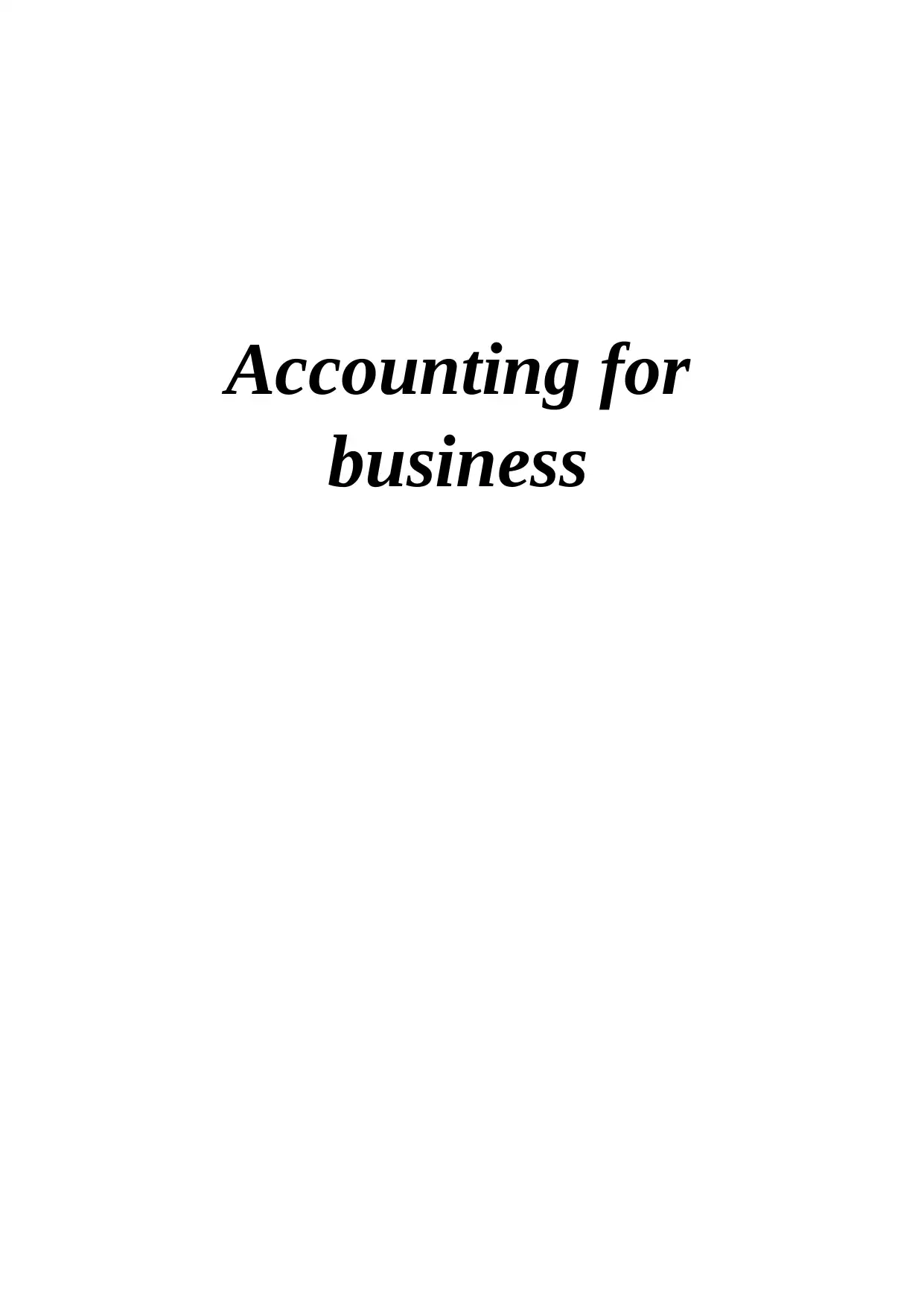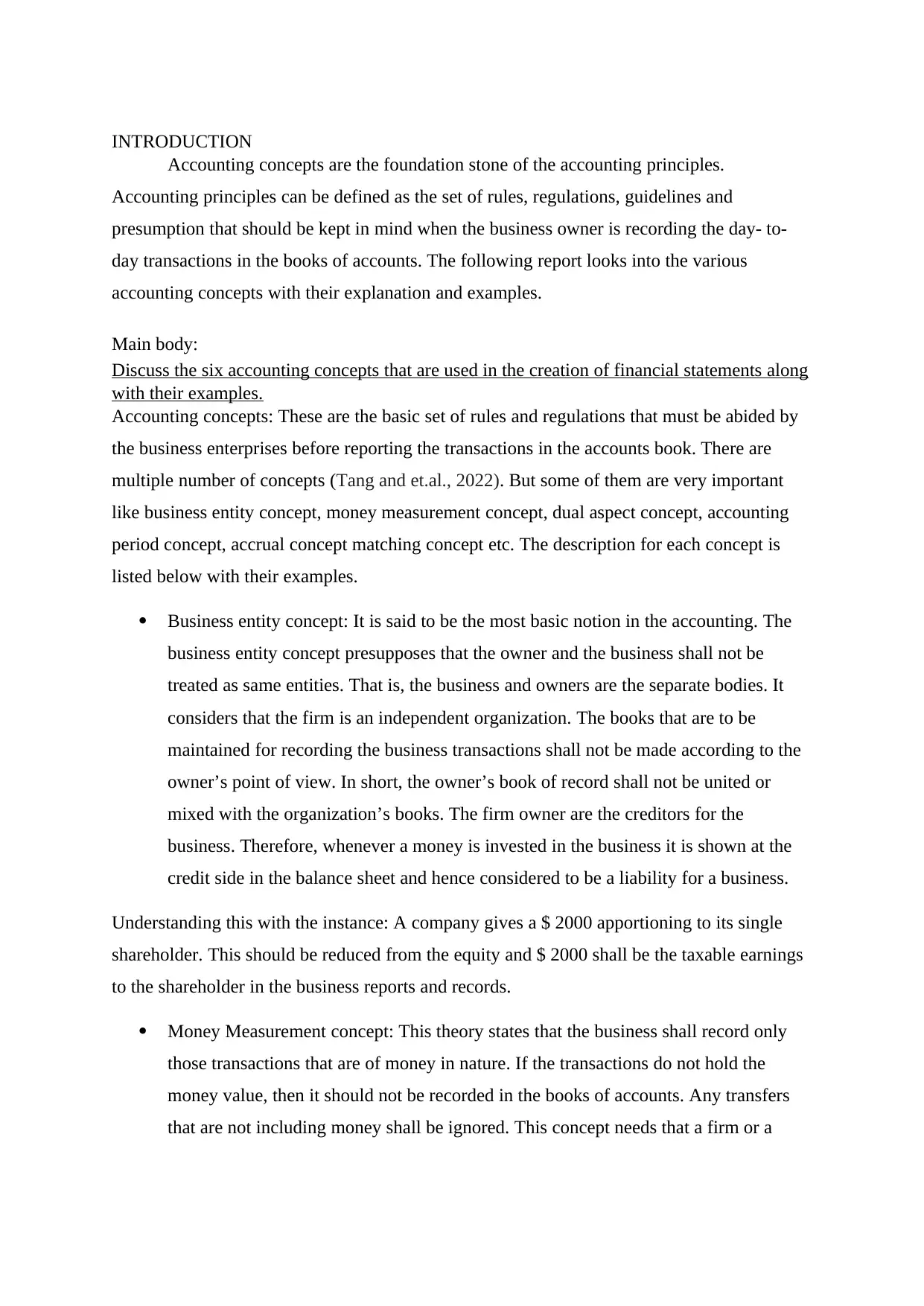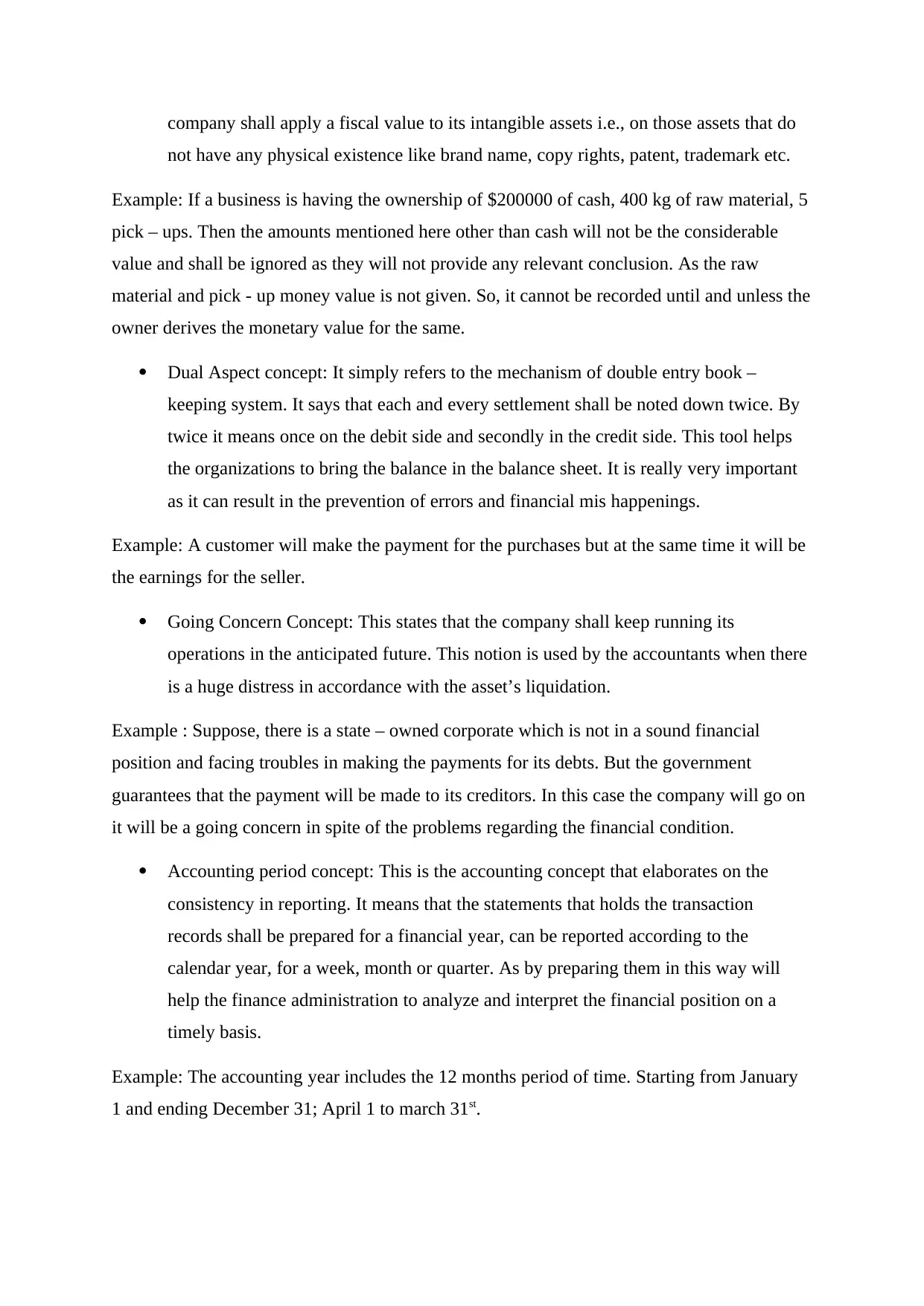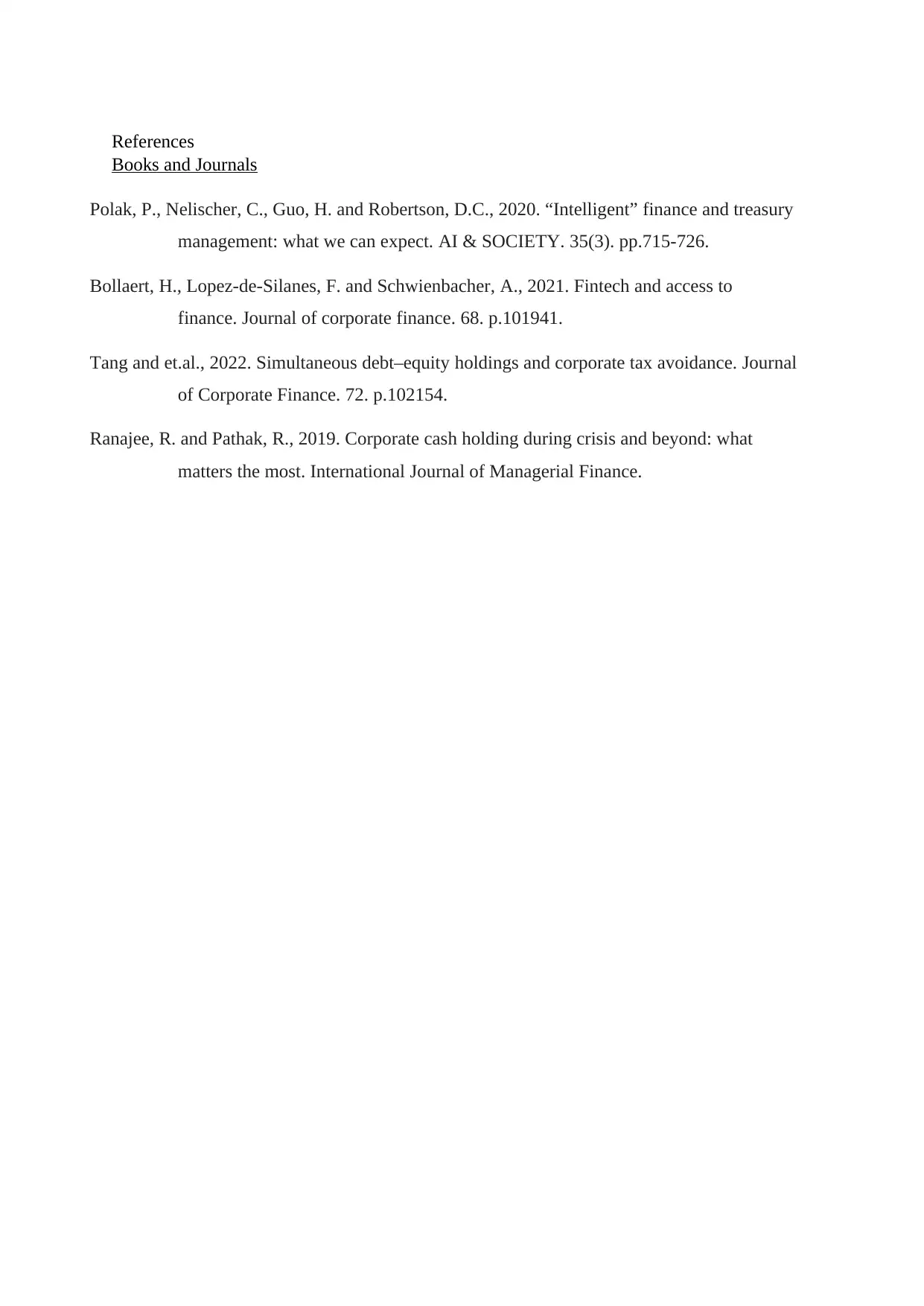Analyzing Accounting Concepts in the Creation of Financial Statements
VerifiedAdded on 2023/06/10
|7
|1193
|468
Report
AI Summary
This report provides a detailed examination of six key accounting concepts used in the creation of financial statements: the business entity concept, which separates the owner from the business; the money measurement concept, which focuses on recording transactions with monetary value; the dual aspect concept, emphasizing the double-entry bookkeeping system; the going concern concept, assuming the business will continue operating; the accounting period concept, ensuring consistent reporting periods; and the matching concept, aligning revenue and expenses within the same accounting period. Each concept is explained with examples to illustrate its application in maintaining accurate and reliable financial records. The report concludes by highlighting the importance of these concepts in determining the fiscal achievements and accomplishments of an organization. Desklib provides access to this and many other solved assignments for students.

Accounting for
business
business
Paraphrase This Document
Need a fresh take? Get an instant paraphrase of this document with our AI Paraphraser

Contents
INTRODUCTION.................................................................................................................................3
Main body:............................................................................................................................................3
Discuss the six accounting concepts that are used in the creation of financial statements along with
their examples....................................................................................................................................3
CONCLUSION.....................................................................................................................................6
References.............................................................................................................................................7
INTRODUCTION.................................................................................................................................3
Main body:............................................................................................................................................3
Discuss the six accounting concepts that are used in the creation of financial statements along with
their examples....................................................................................................................................3
CONCLUSION.....................................................................................................................................6
References.............................................................................................................................................7

INTRODUCTION
Accounting concepts are the foundation stone of the accounting principles.
Accounting principles can be defined as the set of rules, regulations, guidelines and
presumption that should be kept in mind when the business owner is recording the day- to-
day transactions in the books of accounts. The following report looks into the various
accounting concepts with their explanation and examples.
Main body:
Discuss the six accounting concepts that are used in the creation of financial statements along
with their examples.
Accounting concepts: These are the basic set of rules and regulations that must be abided by
the business enterprises before reporting the transactions in the accounts book. There are
multiple number of concepts (Tang and et.al., 2022). But some of them are very important
like business entity concept, money measurement concept, dual aspect concept, accounting
period concept, accrual concept matching concept etc. The description for each concept is
listed below with their examples.
Business entity concept: It is said to be the most basic notion in the accounting. The
business entity concept presupposes that the owner and the business shall not be
treated as same entities. That is, the business and owners are the separate bodies. It
considers that the firm is an independent organization. The books that are to be
maintained for recording the business transactions shall not be made according to the
owner’s point of view. In short, the owner’s book of record shall not be united or
mixed with the organization’s books. The firm owner are the creditors for the
business. Therefore, whenever a money is invested in the business it is shown at the
credit side in the balance sheet and hence considered to be a liability for a business.
Understanding this with the instance: A company gives a $ 2000 apportioning to its single
shareholder. This should be reduced from the equity and $ 2000 shall be the taxable earnings
to the shareholder in the business reports and records.
Money Measurement concept: This theory states that the business shall record only
those transactions that are of money in nature. If the transactions do not hold the
money value, then it should not be recorded in the books of accounts. Any transfers
that are not including money shall be ignored. This concept needs that a firm or a
Accounting concepts are the foundation stone of the accounting principles.
Accounting principles can be defined as the set of rules, regulations, guidelines and
presumption that should be kept in mind when the business owner is recording the day- to-
day transactions in the books of accounts. The following report looks into the various
accounting concepts with their explanation and examples.
Main body:
Discuss the six accounting concepts that are used in the creation of financial statements along
with their examples.
Accounting concepts: These are the basic set of rules and regulations that must be abided by
the business enterprises before reporting the transactions in the accounts book. There are
multiple number of concepts (Tang and et.al., 2022). But some of them are very important
like business entity concept, money measurement concept, dual aspect concept, accounting
period concept, accrual concept matching concept etc. The description for each concept is
listed below with their examples.
Business entity concept: It is said to be the most basic notion in the accounting. The
business entity concept presupposes that the owner and the business shall not be
treated as same entities. That is, the business and owners are the separate bodies. It
considers that the firm is an independent organization. The books that are to be
maintained for recording the business transactions shall not be made according to the
owner’s point of view. In short, the owner’s book of record shall not be united or
mixed with the organization’s books. The firm owner are the creditors for the
business. Therefore, whenever a money is invested in the business it is shown at the
credit side in the balance sheet and hence considered to be a liability for a business.
Understanding this with the instance: A company gives a $ 2000 apportioning to its single
shareholder. This should be reduced from the equity and $ 2000 shall be the taxable earnings
to the shareholder in the business reports and records.
Money Measurement concept: This theory states that the business shall record only
those transactions that are of money in nature. If the transactions do not hold the
money value, then it should not be recorded in the books of accounts. Any transfers
that are not including money shall be ignored. This concept needs that a firm or a
⊘ This is a preview!⊘
Do you want full access?
Subscribe today to unlock all pages.

Trusted by 1+ million students worldwide

company shall apply a fiscal value to its intangible assets i.e., on those assets that do
not have any physical existence like brand name, copy rights, patent, trademark etc.
Example: If a business is having the ownership of $200000 of cash, 400 kg of raw material, 5
pick – ups. Then the amounts mentioned here other than cash will not be the considerable
value and shall be ignored as they will not provide any relevant conclusion. As the raw
material and pick - up money value is not given. So, it cannot be recorded until and unless the
owner derives the monetary value for the same.
Dual Aspect concept: It simply refers to the mechanism of double entry book –
keeping system. It says that each and every settlement shall be noted down twice. By
twice it means once on the debit side and secondly in the credit side. This tool helps
the organizations to bring the balance in the balance sheet. It is really very important
as it can result in the prevention of errors and financial mis happenings.
Example: A customer will make the payment for the purchases but at the same time it will be
the earnings for the seller.
Going Concern Concept: This states that the company shall keep running its
operations in the anticipated future. This notion is used by the accountants when there
is a huge distress in accordance with the asset’s liquidation.
Example : Suppose, there is a state – owned corporate which is not in a sound financial
position and facing troubles in making the payments for its debts. But the government
guarantees that the payment will be made to its creditors. In this case the company will go on
it will be a going concern in spite of the problems regarding the financial condition.
Accounting period concept: This is the accounting concept that elaborates on the
consistency in reporting. It means that the statements that holds the transaction
records shall be prepared for a financial year, can be reported according to the
calendar year, for a week, month or quarter. As by preparing them in this way will
help the finance administration to analyze and interpret the financial position on a
timely basis.
Example: The accounting year includes the 12 months period of time. Starting from January
1 and ending December 31; April 1 to march 31st.
not have any physical existence like brand name, copy rights, patent, trademark etc.
Example: If a business is having the ownership of $200000 of cash, 400 kg of raw material, 5
pick – ups. Then the amounts mentioned here other than cash will not be the considerable
value and shall be ignored as they will not provide any relevant conclusion. As the raw
material and pick - up money value is not given. So, it cannot be recorded until and unless the
owner derives the monetary value for the same.
Dual Aspect concept: It simply refers to the mechanism of double entry book –
keeping system. It says that each and every settlement shall be noted down twice. By
twice it means once on the debit side and secondly in the credit side. This tool helps
the organizations to bring the balance in the balance sheet. It is really very important
as it can result in the prevention of errors and financial mis happenings.
Example: A customer will make the payment for the purchases but at the same time it will be
the earnings for the seller.
Going Concern Concept: This states that the company shall keep running its
operations in the anticipated future. This notion is used by the accountants when there
is a huge distress in accordance with the asset’s liquidation.
Example : Suppose, there is a state – owned corporate which is not in a sound financial
position and facing troubles in making the payments for its debts. But the government
guarantees that the payment will be made to its creditors. In this case the company will go on
it will be a going concern in spite of the problems regarding the financial condition.
Accounting period concept: This is the accounting concept that elaborates on the
consistency in reporting. It means that the statements that holds the transaction
records shall be prepared for a financial year, can be reported according to the
calendar year, for a week, month or quarter. As by preparing them in this way will
help the finance administration to analyze and interpret the financial position on a
timely basis.
Example: The accounting year includes the 12 months period of time. Starting from January
1 and ending December 31; April 1 to march 31st.
Paraphrase This Document
Need a fresh take? Get an instant paraphrase of this document with our AI Paraphraser

Matching concept: It refers to the recording of revenue and expenses, losses and
income in the same accounting period. The company shall report its revenue and
expenses in same year despite of recognizing it in the next year. It plays a great role,
because if a company fails to do so, then it will result in the inconsistency between the
profits and costs incurred by the business enterprise (Ranajee. and Pathak., 2019)
For Ex: If an employee gets $2500 for the extra work that was done for the business. So, this
amount shall be recorded in the same year in which the company has awarded the worker
with this amount.
income in the same accounting period. The company shall report its revenue and
expenses in same year despite of recognizing it in the next year. It plays a great role,
because if a company fails to do so, then it will result in the inconsistency between the
profits and costs incurred by the business enterprise (Ranajee. and Pathak., 2019)
For Ex: If an employee gets $2500 for the extra work that was done for the business. So, this
amount shall be recorded in the same year in which the company has awarded the worker
with this amount.

CONCLUSION
Thus, it can be concluded from the above report that the objective of accounting is to
maintain the systematic record to determine the fiscal achievements and accomplishments of
the organization.
Thus, it can be concluded from the above report that the objective of accounting is to
maintain the systematic record to determine the fiscal achievements and accomplishments of
the organization.
⊘ This is a preview!⊘
Do you want full access?
Subscribe today to unlock all pages.

Trusted by 1+ million students worldwide

References
Books and Journals
Polak, P., Nelischer, C., Guo, H. and Robertson, D.C., 2020. “Intelligent” finance and treasury
management: what we can expect. AI & SOCIETY. 35(3). pp.715-726.
Bollaert, H., Lopez-de-Silanes, F. and Schwienbacher, A., 2021. Fintech and access to
finance. Journal of corporate finance. 68. p.101941.
Tang and et.al., 2022. Simultaneous debt–equity holdings and corporate tax avoidance. Journal
of Corporate Finance. 72. p.102154.
Ranajee, R. and Pathak, R., 2019. Corporate cash holding during crisis and beyond: what
matters the most. International Journal of Managerial Finance.
Books and Journals
Polak, P., Nelischer, C., Guo, H. and Robertson, D.C., 2020. “Intelligent” finance and treasury
management: what we can expect. AI & SOCIETY. 35(3). pp.715-726.
Bollaert, H., Lopez-de-Silanes, F. and Schwienbacher, A., 2021. Fintech and access to
finance. Journal of corporate finance. 68. p.101941.
Tang and et.al., 2022. Simultaneous debt–equity holdings and corporate tax avoidance. Journal
of Corporate Finance. 72. p.102154.
Ranajee, R. and Pathak, R., 2019. Corporate cash holding during crisis and beyond: what
matters the most. International Journal of Managerial Finance.
1 out of 7
Related Documents
Your All-in-One AI-Powered Toolkit for Academic Success.
+13062052269
info@desklib.com
Available 24*7 on WhatsApp / Email
![[object Object]](/_next/static/media/star-bottom.7253800d.svg)
Unlock your academic potential
Copyright © 2020–2025 A2Z Services. All Rights Reserved. Developed and managed by ZUCOL.




